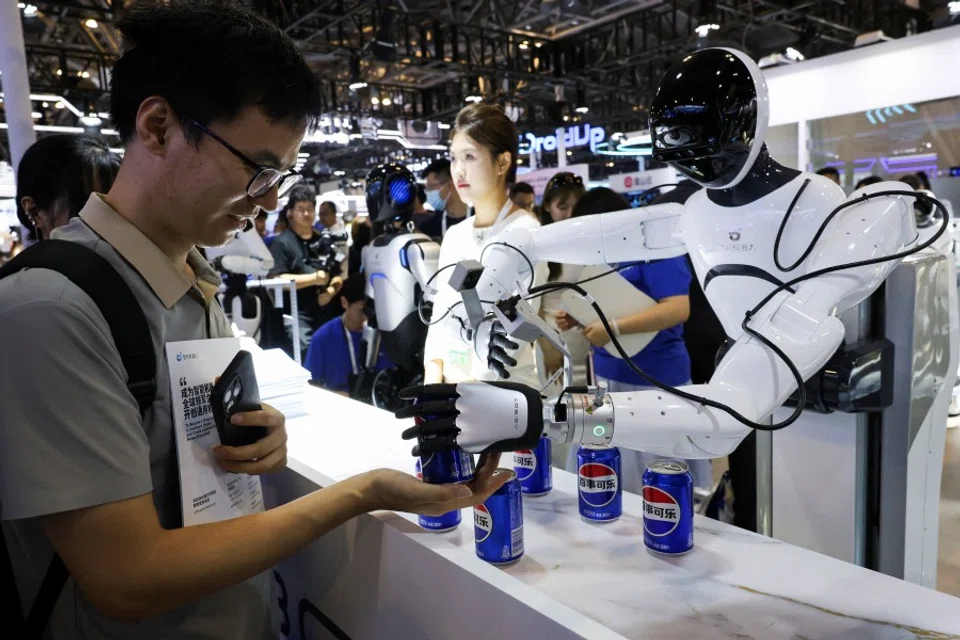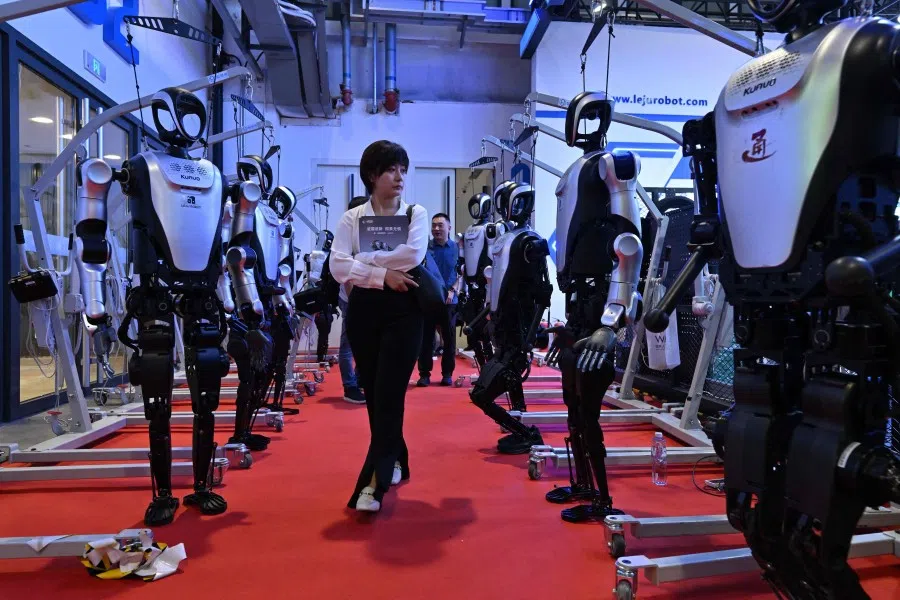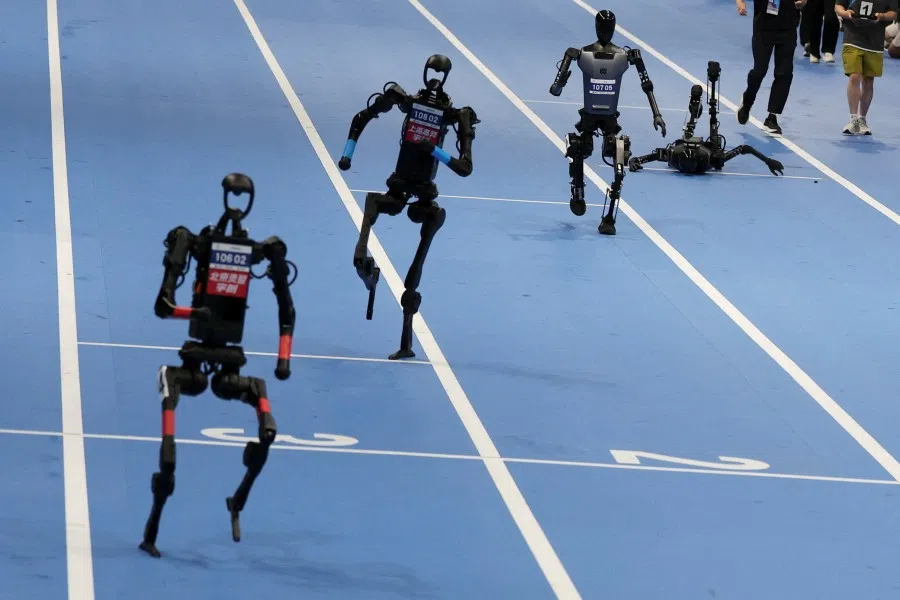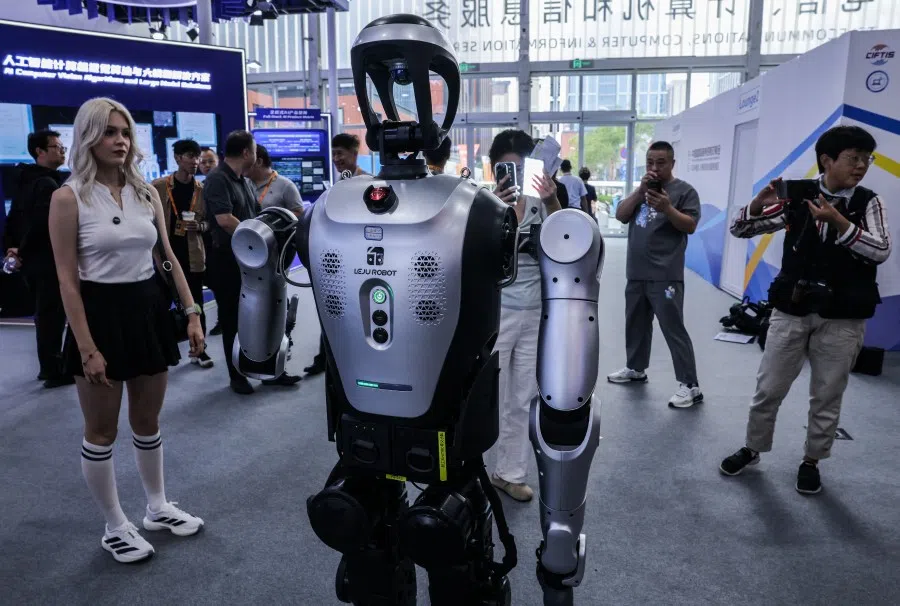Will China be the first to bring humanoid robots into the home?
China is racing to commercialise humanoid robots, aiming beyond factories towards everyday use. But scepticism remains: can these machines move from demos and hype into real homes — and real lives? Lianhe Zaobao correspondent Yush Chau finds out more.

In mid-August this year, the inaugural World Humanoid Robot Games was held in Beijing. China’s humanoid robots dazzled in events such as running, high jump, soccer and kickboxing, showcasing the country’s latest breakthroughs in embodied intelligence and drawing global attention.
Immense potential in industrial settings
Unitree Robotics, one of the “Six Little Dragons of Hangzhou”, stood out in particular. The company’s first humanoid robot, H1, won the very first gold medal of the games with a time of 6 minutes and 34 seconds in the 1,500-metre race, while its second robot, G1, took part in the kickboxing event.
However, after the excitement of the competition, a key question remains: when will humanoid robots go from a novelty to something useful in everyday life?
In the same week as the games, the 10th World Robot Conference was also held in Beijing. At the conference, Shenzhen-based robotics company UBTECH showcased the practical applications of humanoid robots in industrial settings. These robots are not just capable of tasks such as material handling, sorting and quality inspection, but also of autonomously replacing their own batteries.
... industrial scenarios — being structured and predictable — are well-suited as an entry point for deploying humanoid robots, as they facilitate model training and product adaptation. — Zheng Yu, Vice-Dean, UBTECH’s Research Institute

Zheng Yu, vice-dean of UBTECH’s Research Institute and a humanoid robotics scientist, told Lianhe Zaobao that industrial scenarios — being structured and predictable — are well-suited as an entry point for deploying humanoid robots, as they facilitate model training and product adaptation. He noted that although real-world applications are still in their early stages, the commercialisation potential is immense.
At the opening ceremony of the conference, the Chinese Institute of Electronics announced the top ten potential application scenarios for humanoid robots. These include industrial operations such as loading and unloading, material transfer, sorting and batching in automobile manufacturing; grinding and polishing in shipbuilding; inspection along petrochemical production lines; and power plant operations. On the consumer side, the applications extend to commercial guiding, household assistance and emotional companionship.
Limited practicality at home
Bu Canhua, an electronics industry analyst at Huaxi Securities, noted in an interview that for highly repetitive tasks, robotic arms are generally more efficient and cost-effective than humanoid robots. At present, the overall cost-performance ratio of humanoid robots remains relatively low, limited by hardware and software technologies.
Zheng Yu also pointed out that some factory tasks that may seem simple — such as material handling and palletising — are in fact quite challenging for humanoid robots. “To achieve efficient, autonomous and stable handling would depend on the robot’s own perception capabilities,” he said.
The R1 weighs 25 kilograms and is capable of doing somersaults, boxing and running downhill. But many Chinese netizens are unconvinced, asking, “What’s the point of buying one?”
For ordinary consumers, humanoid robots are currently expensive and lack practicality.
In July this year, Unitree Robotics launched the humanoid robot R1, priced at 39,900 RMB (US$5,600), a sharp drop compared with the H1 (650,000 RMB) and G1 (99,000 RMB). The R1 weighs 25 kilograms and is capable of doing somersaults, boxing and running downhill. But many Chinese netizens are unconvinced, asking, “What’s the point of buying one?”

Unitree founder Wang Xingxing told China’s state media, People’s Daily, that there is still a long way to go before humanoid robots become a part of daily life and enter every home. The industry is still in its early stages, so it must start with smaller areas, such as scientific research and education, service demonstrations, simple industrial applications, and being used by artificial intelligence (AI) companies for development.
He also pointed out that the biggest challenge for large-scale deployment of humanoid robots is that the level of robot AI is not advanced enough to break the critical threshold; this is a common global issue and what everyone is striving to solve.
Breakthrough stage
Bu Canhua believes that the biggest challenge for Chinese companies right now is the lack of clarity on the essential needs of the consumer market — whether humanoid robots should primarily be used for household chores, emotional companionship, or other purposes remains to be explored.
... the humanoid robotics industry is currently at a breakthrough stage — moving “from 0 to 1” in developing the first viable humanoid robots for the consumer market. — Bu Canhua, electronics industry analyst, Huaxi Securities
He added, however, that the humanoid robotics industry is currently at a breakthrough stage — moving “from 0 to 1” in developing the first viable humanoid robots for the consumer market. Regardless of company size, as long as it can accurately identify demand and quickly establish a viable commercial cycle, it may be able to achieve a leapfrog advantage.
While there are many challenges in commercialisation, China’s rapid progress in the field of humanoid robotics continues to attract global attention.

When interviewed, Xie Ming, president of the Robotics Society of Singapore and associate professor at Nanyang Technological University’s School of Mechanical and Aerospace Engineering, said that humanoid robots integrate hardware, software, algorithms and system design, making them an important symbol of a country’s technological strength.
He analysed that China has the edge in this regard. First, it has a complete manufacturing chain and vast application scenarios, enabling rapid product iteration and accelerating deployment in industries such as security, logistics, education and elderly care; second, it enjoys sustained policy and capital support, with cities such as Beijing, Shenzhen and Shanghai having already built complete ecosystems spanning from basic research to application transfer.
Xu Jin, a general manager at Black Sesame Technologies Singapore — a company engaged in autonomous driving and robotic chip manufacturing — predicted that in the next three to five years, China will first achieve breakthroughs in specific vertical scenarios such as security inspections, educational companionship and elderly care, rather than directly deploying “all-purpose” humanoid robots.
China leading in scale, catching up in technology
At the policy level, China released guiding opinions in 2023 to support the innovative development of humanoid robots, setting phased industry goals. By 2025, targets include aligning fully built units with international standards, beginning mass production, and piloting applications in manufacturing, public services, and other sectors — alongside exploring effective governance models. By 2027, the focus shifts to strengthening innovation capacity, building secure and reliable supply chains, and developing a globally competitive industrial ecosystem.
American companies are already exploring an integrated “vision + cognition” pathway, enabling robots to perform more complex tasks through visual perception and cognitive planning. By contrast, most Chinese robots still rely primarily on motion control...

In a February report, Morgan Stanley noted that over the past five years, China successfully filed 5,688 patents related to humanoid robots — far exceeding the 1,483 and 1,195 filed by the US and Japan respectively during the same period. Last year, Chinese companies launched 35 humanoid robot models, accounting for two-thirds of the global total, while companies in the US and Canada released only eight.
Although on the surface China appears to dominate the humanoid robotics field, Xie Ming pointed out that the country is still in a stage of “leading in scale but catching up in technology”. In particular, it still lags behind in the deep integration of humanoid robots’ motor skills and cognitive abilities.
He noted that American companies are already exploring an integrated “vision + cognition” pathway, enabling robots to perform more complex tasks through visual perception and cognitive planning. By contrast, most Chinese robots still rely primarily on motion control — for example, climbing stairs by mechanically “bumping up step by step” — with limited visual understanding of their environment, often requiring additional development and scenario adaptation by manufacturers.
This article was first published in Lianhe Zaobao as “从炫技到实用 中国人形机器人走进生活要多久?”.



![[Big read] China’s 10 trillion RMB debt clean-up falls short](https://cassette.sphdigital.com.sg/image/thinkchina/d08cfc72b13782693c25f2fcbf886fa7673723efca260881e7086211b082e66c)

